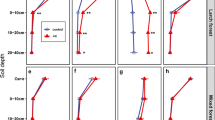ABSTRACT
The relationship between soil nitrogen (N) availability and plant community structure was investigated in old-fields in the shortgrass steppe of Colorado. Nitrogen availability was manipulated by N or sucrose additions for 4 years at three old-fields (early-seral, mid-seral, and late-seral) and at an uncultivated control site. The addition of N generally resulted in increased abundance of annual forbs and grasses relative to perennials at all of the previously cultivated sites. Conversely, experimental reduction of N availability generally increased the relative abundance of perennials. Despite a lack of detectable differences in N mineralization between sites and treatments, ion-exchange resin bags confirmed that sucrose additions reduced plant-available N and that N additions increased plant-available N. This was evidenced further by similar observations for plant tissue N content. The degree to which N additions increased N availability at the various sites supported the idea that late-seral plant communities are less effective at N capture relative to earlier-seral communities. The mid-seral old-field had the lowest rates of litter decomposition and a relatively large accumulation of litter on the soil surface. This mid-seral old-field was dominated by an exotic annual grass (Bromus tectorum), which appears to be a major hindrance to redevelopment of the plant-soil system. By experimentally reducing N availability at this stage, we were able, in 4 years, to change the plant community into one that more closely resembled the late-seral community. We also observed that the natural recruitment of weedy annual species on the uncultivated site during an unusually wet year was suppressed by reducing N availability. Our results suggest that available N is an important factor controlling the rate and course of plant and soil community redevelopment on abandoned croplands in the shortgrass steppe, and that manipulation of N availability might be useful in restoration of rangeland vegetation.
Similar content being viewed by others
Author information
Authors and Affiliations
Additional information
Received 19 May 1998; accepted 27 August 1999.
Rights and permissions
About this article
Cite this article
Paschke, M., McLendon, T. & Redente, E. Original Articles: Nitrogen Availability and Old-Field Succession in a Shortgrass Steppe. Ecosystems 3, 144–158 (2000). https://doi.org/10.1007/s100210000016
Issue Date:
DOI: https://doi.org/10.1007/s100210000016




